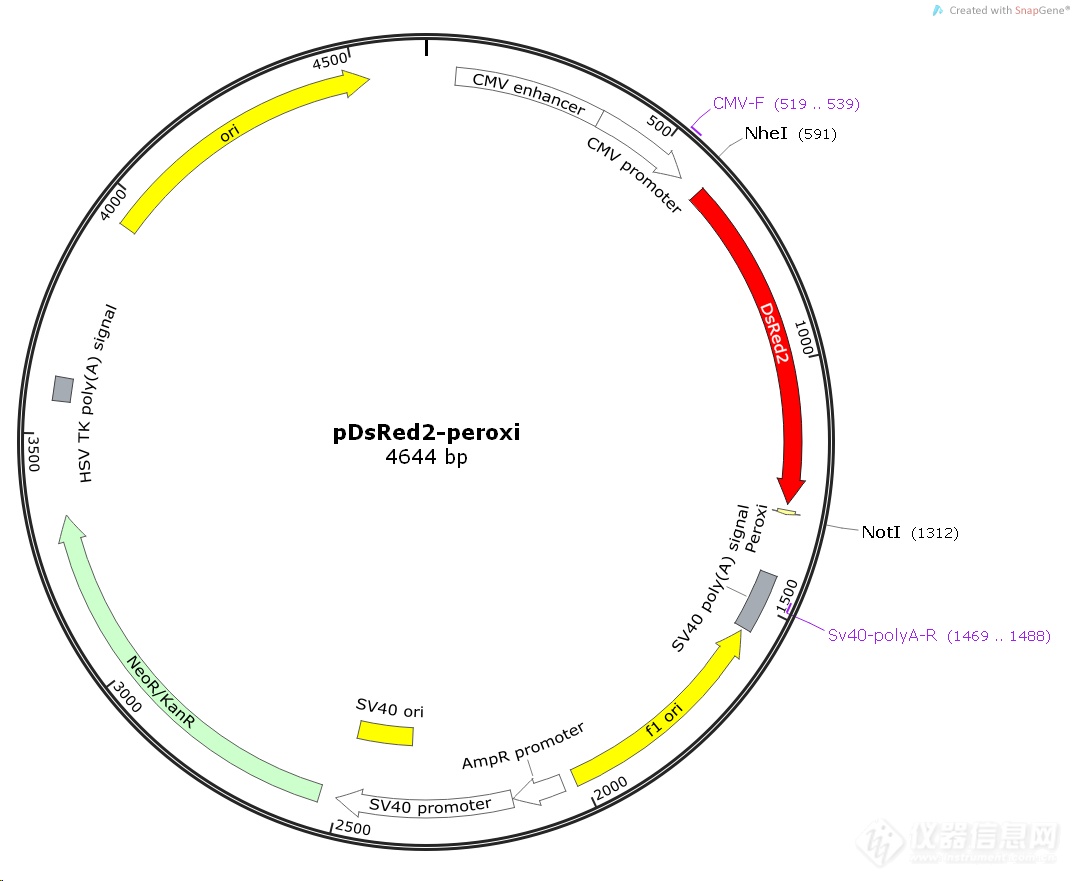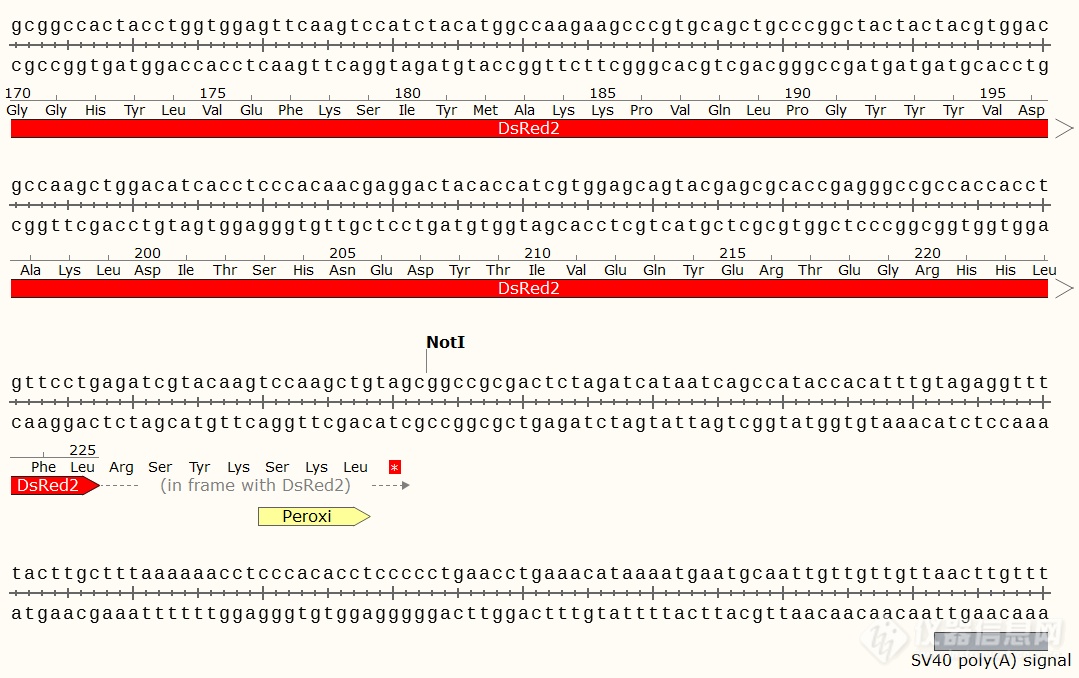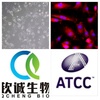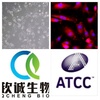
产品详情
pDsRed2-Peroxi过氧化物酶体定位质粒
基本信息
启动子: CMV promoter
复制子: pUC ori,f1 ori
终止子: SV40 poly(A) signal
质粒分类: 哺乳系列质粒;哺乳荧光质粒;哺乳红色质粒
质粒大小: 4644bp
质粒标签: N-DsRed2,C-peroxi
原核抗性: 卡纳霉素Kan(50μg/ml)
筛选标记: 新霉素Neo/G418
克隆菌株: DH5α等大肠杆菌
培养条件: 37℃,LB,有氧
表达宿主: 293T等哺乳细胞
培养条件: 37℃,5%CO2
诱导方式: 无须诱导,瞬时表达
5'测序引物: CMV-F(CGCAAATGGGCGGTAGGCGTG)
3'测序引物: Sv40-polyA-R(GAAATTTGTGATGCTATTGC)
质粒简介
pDsRed2-Peroxi是一种哺乳动物表达载体,其编码Discosoma sp红色荧光蛋白(DsRed2)和过氧化物酶体靶向信号1(PTS1).PTS1序列与DsRed2的3'末端融合,DsRed变体设计用于更快的成熟和较低的非特异性聚集.PTS1序列编码三肽SKL,其中将DsRed2-PTS1融合蛋白靶向过氧化物酶体基质。
pDsRed2-Peroxi is a mammalian expression vector that encodes a fusion of Discosoma sp. Red fluorescent protein (DsRed2; 1, 2) and the peroxisomal targeting signal 1 (PTS1). The PTS1 sequence is fused to the 3'-end of DsRed2, a DsRed variant engineered for faster maturation and lower non-specific aggregation. The PTS1 sequence encodes the tripeptide SKL, which targets the DsRed2-PTS1 fusion protein to the matrix of peroxisomes (3–6).
To drive expression of DsRed2-PTS1, this vector contains the immediate early promoter of cytomegalovirus (PCMV IE). SV40 polyadenylation signals downstream of the DsRed2 gene direct proper processing of the 3'-end of the DsRed2-PTS1 mRNA transcript. Because it encodes DsRed2, a gene variant that uses human-preferred codons (7), the DsRed2-PTS1 transcript is suited for efficient translation in mammalian cells. To further increase the translational efficiency of DsRed2-PTS1, upstream sequences have been converted to a Kozak consensus translation initiation site (8). The vector also contains an SV40 origin for replication in any mammalian cell line that expresses the SV40 T-antigen, a pUC origin of replication for propagation in E. coli, and an f1 origin for single-stranded DNA production. A neomycin resistance cassette—consisting of the SV40 early promoter (PSV40e), the neomycin/kanamycin resistance gene of Tn5 (Neor/Kanr), and polyadenylation signals from the herpes simplex virus thymidine kinase (HSV TK polyA) gene—allow stably transfected eukaryotic cells to be selected using G418 (9). A bacterial promoter (P) upstream of this cassette drives expression of the gene encoding kanamycin resistance in E. coli.
pDsRed2-Peroxi is designed for fluorescent labeling of peroxisomes. The vector can be introduced into mammalian cells using any standard transfection method. If required, stable transformants can be selected using G418 (9). The DsRed2-PTS1 fusion (excitation/emission maxima: 558 nm/583 nm) can be detected by fluorescence microscopy and by flow cytometry. Filter sets optimized for detecting DsRed by microscopy are available from Chroma Technology Corporation and Omega Optical Inc. Please see their websites (www.chroma.com and www.omegafilters.com) and the Living Colors® Vol. II User Manual, provided with this vector, for more information. To detect DsRed2-PTS1-expressing cells by flow cytometry, use the instrument’s argon-ion laser to excite the fluorophore at 488 nm and the FL-2 channel to detect the fluorophore’s emission at 583 nm.
• Suitable host strains: DH5α, HB101 and other general purpose strains. Single-stranded DNA production requires a host containing an F plasmid such as JM101 or XL1-Blue.
• Selectable marker: plasmid confers resistance to kanamycin (50 μg/ml) to E. coli hosts.
• E. coli replication origin: pUC
• Copy number: ~500
• Plasmid incompatibility group: pMB1/ColE1
质粒图谱

pDsRed2-Peroxi过氧化物酶体定位质粒使用说明:
1、收到质粒干粉后请先5000rpm离心1min,再加入20μl无菌水溶解质粒,室温放置1min;
2、从-80℃冰箱中取出相应的感受态,置于冰盒上解冻,并做好标记;
3、取2μl质粒加至100μl感受态中,冰浴30min;
4、42℃热激90s,再冰浴2min;
5、加入900μl无抗的LB液体培养基,180rpm震荡培养45min;
6、6000rpm离心5min,仅留100ul上清混匀菌体沉淀;
7、混匀后的菌液加至对应抗性的LB平板上,倒入适量玻璃珠,涂匀液体;
8、将平板正向培养1h,再倒置培养12h~16h;
9、挑取单克隆菌落至对应抗性的LB液体培养基中,震荡培养12h~16h,根据实验需要提取质粒。
pDsRed2-Peroxi过氧化物酶体定位质粒注意事项:
1、如果您收到的是甘油菌种,请先四区划线,挑取单克隆培养。
2、如果第二天转化平板长的过多,请将质粒按比例稀释后再转化。
问商家




